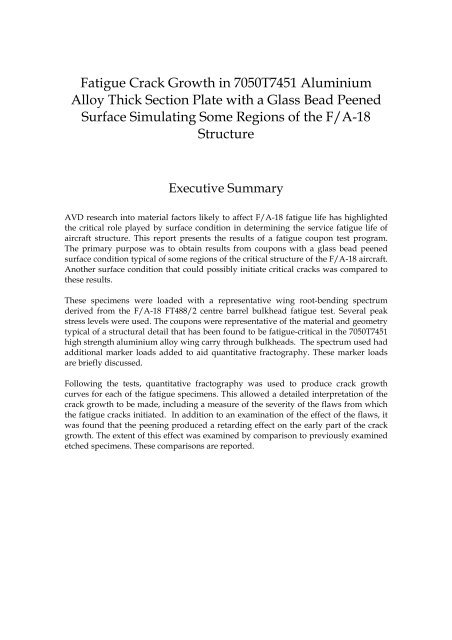Fatigue Crack Growth in 7050T7451 Aluminium Alloy Thick Section ...
Fatigue Crack Growth in 7050T7451 Aluminium Alloy Thick Section ...
Fatigue Crack Growth in 7050T7451 Aluminium Alloy Thick Section ...
You also want an ePaper? Increase the reach of your titles
YUMPU automatically turns print PDFs into web optimized ePapers that Google loves.
<strong>Fatigue</strong> <strong>Crack</strong> <strong>Growth</strong> <strong>in</strong> <strong>7050T7451</strong> Alum<strong>in</strong>ium<strong>Alloy</strong> <strong>Thick</strong> <strong>Section</strong> Plate with a Glass Bead PeenedSurface Simulat<strong>in</strong>g Some Regions of the F/A-18StructureExecutive SummaryAVD research <strong>in</strong>to material factors likely to affect F/A-18 fatigue life has highlightedthe critical role played by surface condition <strong>in</strong> determ<strong>in</strong><strong>in</strong>g the service fatigue life ofaircraft structure. This report presents the results of a fatigue coupon test program.The primary purpose was to obta<strong>in</strong> results from coupons with a glass bead peenedsurface condition typical of some regions of the critical structure of the F/A-18 aircraft.Another surface condition that could possibly <strong>in</strong>itiate critical cracks was compared tothese results.These specimens were loaded with a representative w<strong>in</strong>g root-bend<strong>in</strong>g spectrumderived from the F/A-18 FT488/2 centre barrel bulkhead fatigue test. Several peakstress levels were used. The coupons were representative of the material and geometrytypical of a structural detail that has been found to be fatigue-critical <strong>in</strong> the <strong>7050T7451</strong>high strength alum<strong>in</strong>ium alloy w<strong>in</strong>g carry through bulkheads. The spectrum used hadadditional marker loads added to aid quantitative fractography. These marker loadsare briefly discussed.Follow<strong>in</strong>g the tests, quantitative fractography was used to produce crack growthcurves for each of the fatigue specimens. This allowed a detailed <strong>in</strong>terpretation of thecrack growth to be made, <strong>in</strong>clud<strong>in</strong>g a measure of the severity of the flaws from whichthe fatigue cracks <strong>in</strong>itiated. In addition to an exam<strong>in</strong>ation of the effect of the flaws, itwas found that the peen<strong>in</strong>g produced a retard<strong>in</strong>g effect on the early part of the crackgrowth. The extent of this effect was exam<strong>in</strong>ed by comparison to previously exam<strong>in</strong>edetched specimens. These comparisons are reported.
















